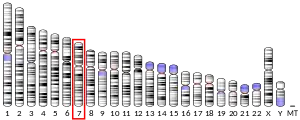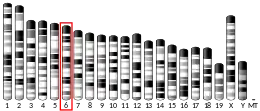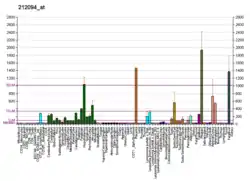PEG10
Retrotransposon-derived protein PEG10 is a protein that in humans is encoded by the PEG10 gene.[5][6][7][8]
Function
This gene includes two overlapping reading frames of the same transcript encoding distinct isoforms. The shorter isoform has a CCHC-type zinc finger motif containing a sequence characteristic of gag proteins of most retroviruses and some retrotransposons, and it functions in part by interacting with members of the TGF-beta receptor family. The longer isoform has the active-site DSG consensus sequence of the protease domain of pol proteins. The longer isoform is the result of -1 translational frameshifting that is also seen in some retroviruses. Expression of these two isoforms only comes from the paternal allele due to imprinting. Increased gene expression (as observed by an increase in mRNA levels) is associated with hepatocellular carcinomas.[8]
PEG10 is a paternally expressed imprinted gene that is expressed in adult and embryonic tissues.[9] Most notable expression occurs in the placenta. This gene is highly conserved across mammalian species and retains the heptanucleotide (GGGAAAC). This gene has been reported to play a role in cell proliferation, differentiation and apoptosis. Overexpression of this gene has been associated with several malignancies, such as hepatocellular carcinoma and B-cell lymphocytic leukemia. Knockout mice lacking this gene showed early embryonic lethality with placental defects, indicating the importance of this gene in embryonic development. In preeclampsia placental tissue, PEG10 has been shown to be downregulated[10] and upregulated[11] implicating it as a possible causal role in the occurrence of preeclampsia.
References
- GRCh38: Ensembl release 89: ENSG00000242265 - Ensembl, May 2017
- GRCm38: Ensembl release 89: ENSMUSG00000092035 - Ensembl, May 2017
- "Human PubMed Reference:". National Center for Biotechnology Information, U.S. National Library of Medicine.
- "Mouse PubMed Reference:". National Center for Biotechnology Information, U.S. National Library of Medicine.
- Ono R, Kobayashi S, Wagatsuma H, Aisaka K, Kohda T, Kaneko-Ishino T, Ishino F (Apr 2001). "A retrotransposon-derived gene, PEG10, is a novel imprinted gene located on human chromosome 7q21". Genomics. 73 (2): 232–7. doi:10.1006/geno.2001.6494. PMID 11318613.
- Brandt J, Schrauth S, Veith AM, Froschauer A, Haneke T, Schultheis C, Gessler M, Leimeister C, Volff JN (Jan 2005). "Transposable elements as a source of genetic innovation: expression and evolution of a family of retrotransposon-derived neogenes in mammals". Gene. 345 (1): 101–11. doi:10.1016/j.gene.2004.11.022. PMID 15716091.
- Brandt J, Veith AM, Volff JN (Aug 2005). "A family of neofunctionalized Ty3/gypsy retrotransposon genes in mammalian genomes". Cytogenetic and Genome Research. 110 (1–4): 307–17. doi:10.1159/000084963. PMID 16093683. S2CID 38398479.
- "Entrez Gene: PEG10 paternally expressed 10".
- "PEG10 paternally expressed 10 [ Homo sapiens (human) ]". Pubmed. Retrieved 14 April 2015.
- Liang XY, Chen X, Jin YZ, Chen XO, Chen QZ (Dec 18, 2014). "Expression and significance of the imprinted gene PEG10 in placenta of patients with preeclampsia". Genetics and Molecular Research. 13 (4): 10607–14. doi:10.4238/2014.December.18.2. PMID 25526181.
- Chen H, Sun M, Zhao G, Liu J, Gao W, Si S, Meng T (Oct 2012). "Elevated expression of PEG10 in human placentas from preeclamptic pregnancies". Acta Histochemica. 114 (6): 589–93. doi:10.1016/j.acthis.2011.11.003. PMID 22137777.
- Okabe H, Satoh S, Furukawa Y, Kato T, Hasegawa S, Nakajima Y, Yamaoka Y, Nakamura Y (Jun 2003). "Involvement of PEG10 in human hepatocellular carcinogenesis through interaction with SIAH1". Cancer Research. 63 (12): 3043–8. PMID 12810624.
Further reading
- Andersson B, Wentland MA, Ricafrente JY, Liu W, Gibbs RA (Apr 1996). "A "double adaptor" method for improved shotgun library construction". Analytical Biochemistry. 236 (1): 107–13. doi:10.1006/abio.1996.0138. PMID 8619474.
- Yu W, Andersson B, Worley KC, Muzny DM, Ding Y, Liu W, Ricafrente JY, Wentland MA, Lennon G, Gibbs RA (Apr 1997). "Large-scale concatenation cDNA sequencing". Genome Research. 7 (4): 353–8. doi:10.1101/gr.7.4.353. PMC 139146. PMID 9110174.
- Kikuno R, Nagase T, Ishikawa K, Hirosawa M, Miyajima N, Tanaka A, Kotani H, Nomura N, Ohara O (Jun 1999). "Prediction of the coding sequences of unidentified human genes. XIV. The complete sequences of 100 new cDNA clones from brain which code for large proteins in vitro". DNA Research. 6 (3): 197–205. doi:10.1093/dnares/6.3.197. PMID 10470851.
- Volff J, Körting C, Schartl M (Feb 2001). "Ty3/Gypsy retrotransposon fossils in mammalian genomes: did they evolve into new cellular functions?". Molecular Biology and Evolution. 18 (2): 266–70. doi:10.1093/oxfordjournals.molbev.a003801. PMID 11158386.
- Shigemoto K, Brennan J, Walls E, Watson CJ, Stott D, Rigby PW, Reith AD (Oct 2001). "Identification and characterisation of a developmentally regulated mammalian gene that utilises -1 programmed ribosomal frameshifting". Nucleic Acids Research. 29 (19): 4079–88. doi:10.1093/nar/29.19.4079. PMC 60235. PMID 11574691.
- Smallwood A, Papageorghiou A, Nicolaides K, Alley MK, Jim A, Nargund G, Ojha K, Campbell S, Banerjee S (Jul 2003). "Temporal regulation of the expression of syncytin (HERV-W), maternally imprinted PEG10, and SGCE in human placenta". Biology of Reproduction. 69 (1): 286–93. doi:10.1095/biolreprod.102.013078. PMID 12620933.
- Okabe H, Satoh S, Furukawa Y, Kato T, Hasegawa S, Nakajima Y, Yamaoka Y, Nakamura Y (Jun 2003). "Involvement of PEG10 in human hepatocellular carcinogenesis through interaction with SIAH1". Cancer Research. 63 (12): 3043–8. PMID 12810624.
- Tsou AP, Chuang YC, Su JY, Yang CW, Liao YL, Liu WK, Chiu JH, Chou CK (2004). "Overexpression of a novel imprinted gene, PEG10, in human hepatocellular carcinoma and in regenerating mouse livers". Journal of Biomedical Science. 10 (6 Pt 1): 625–35. doi:10.1159/000073528. PMID 14576465. S2CID 202655065.
- Suzuki Y, Yamashita R, Shirota M, Sakakibara Y, Chiba J, Mizushima-Sugano J, Nakai K, Sugano S (Sep 2004). "Sequence comparison of human and mouse genes reveals a homologous block structure in the promoter regions". Genome Research. 14 (9): 1711–8. doi:10.1101/gr.2435604. PMC 515316. PMID 15342556.
- Lux A, Beil C, Majety M, Barron S, Gallione CJ, Kuhn HM, Berg JN, Kioschis P, Marchuk DA, Hafner M (Mar 2005). "Human retroviral gag- and gag-pol-like proteins interact with the transforming growth factor-beta receptor activin receptor-like kinase 1". The Journal of Biological Chemistry. 280 (9): 8482–93. doi:10.1074/jbc.M409197200. PMID 15611116.
- Manktelow E, Shigemoto K, Brierley I (2005). "Characterization of the frameshift signal of Edr, a mammalian example of programmed -1 ribosomal frameshifting". Nucleic Acids Research. 33 (5): 1553–63. doi:10.1093/nar/gki299. PMC 1065257. PMID 15767280.
- He H, Olesnanik K, Nagy R, Liyanarachchi S, Prasad ML, Stratakis CA, Kloos RT, de la Chapelle A (Jul 2005). "Allelic variation in gene expression in thyroid tissue". Thyroid. 15 (7): 660–7. doi:10.1089/thy.2005.15.660. PMID 16053381.
- Hu C, Xiong J, Zhang L, Huang B, Zhang Q, Li Q, Yang M, Wu Y, Wu Q, Shen Q, Gao Q, Zhang K, Sun Z, Liu J, Jin Y, Tan J (Aug 2004). "PEG10 activation by co-stimulation of CXCR5 and CCR7 essentially contributes to resistance to apoptosis in CD19+CD34+ B cells from patients with B cell lineage acute and chronic lymphocytic leukemia". Cellular & Molecular Immunology. 1 (4): 280–94. PMID 16225771.
- Kimura K, Wakamatsu A, Suzuki Y, Ota T, Nishikawa T, Yamashita R, Yamamoto J, Sekine M, Tsuritani K, Wakaguri H, Ishii S, Sugiyama T, Saito K, Isono Y, Irie R, Kushida N, Yoneyama T, Otsuka R, Kanda K, Yokoi T, Kondo H, Wagatsuma M, Murakawa K, Ishida S, Ishibashi T, Takahashi-Fujii A, Tanase T, Nagai K, Kikuchi H, Nakai K, Isogai T, Sugano S (Jan 2006). "Diversification of transcriptional modulation: large-scale identification and characterization of putative alternative promoters of human genes". Genome Research. 16 (1): 55–65. doi:10.1101/gr.4039406. PMC 1356129. PMID 16344560.
- Li CM, Margolin AA, Salas M, Memeo L, Mansukhani M, Hibshoosh H, Szabolcs M, Klinakis A, Tycko B (Jan 2006). "PEG10 is a c-MYC target gene in cancer cells". Cancer Research. 66 (2): 665–72. doi:10.1158/0008-5472.CAN-05-1553. PMID 16423995.





